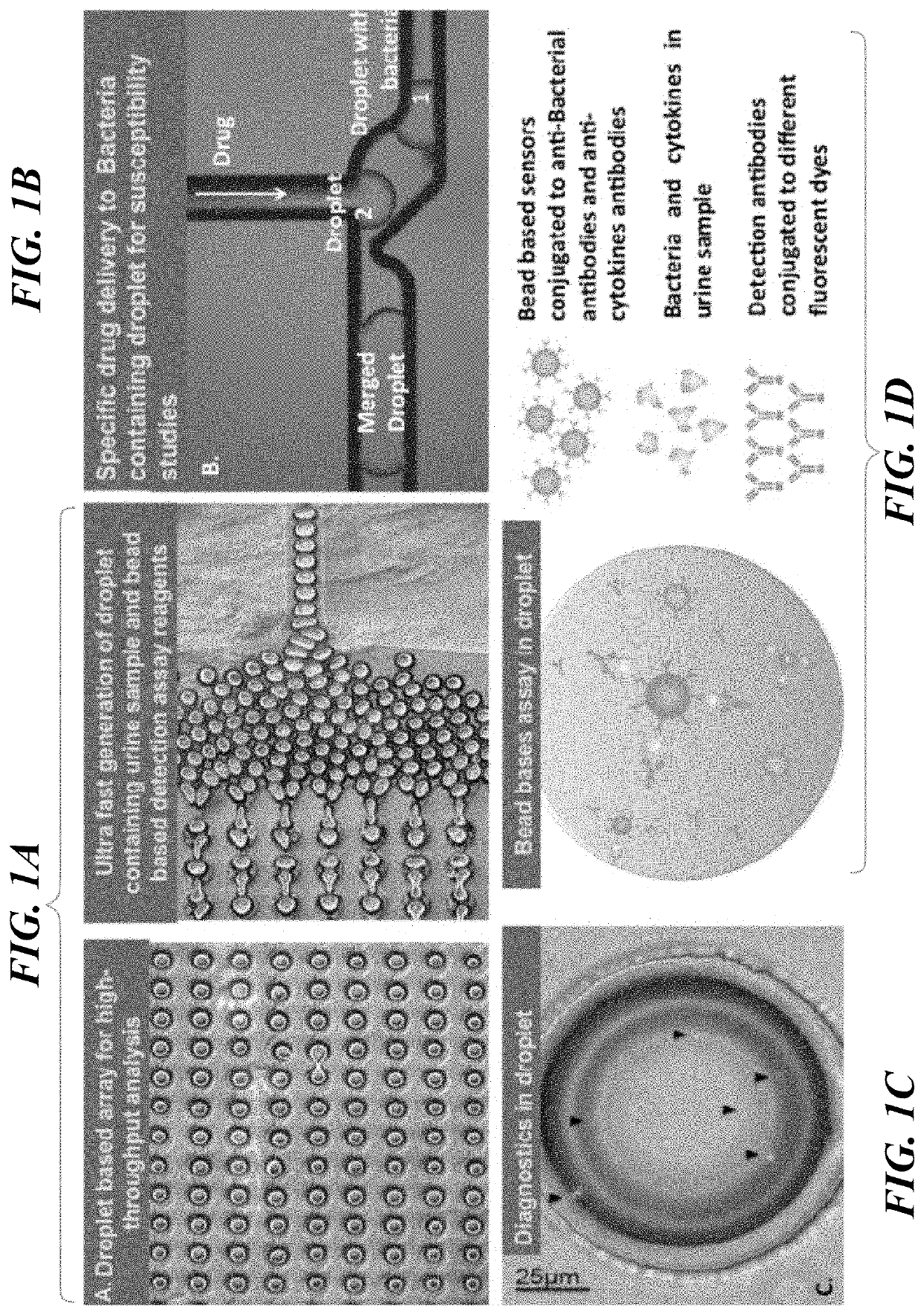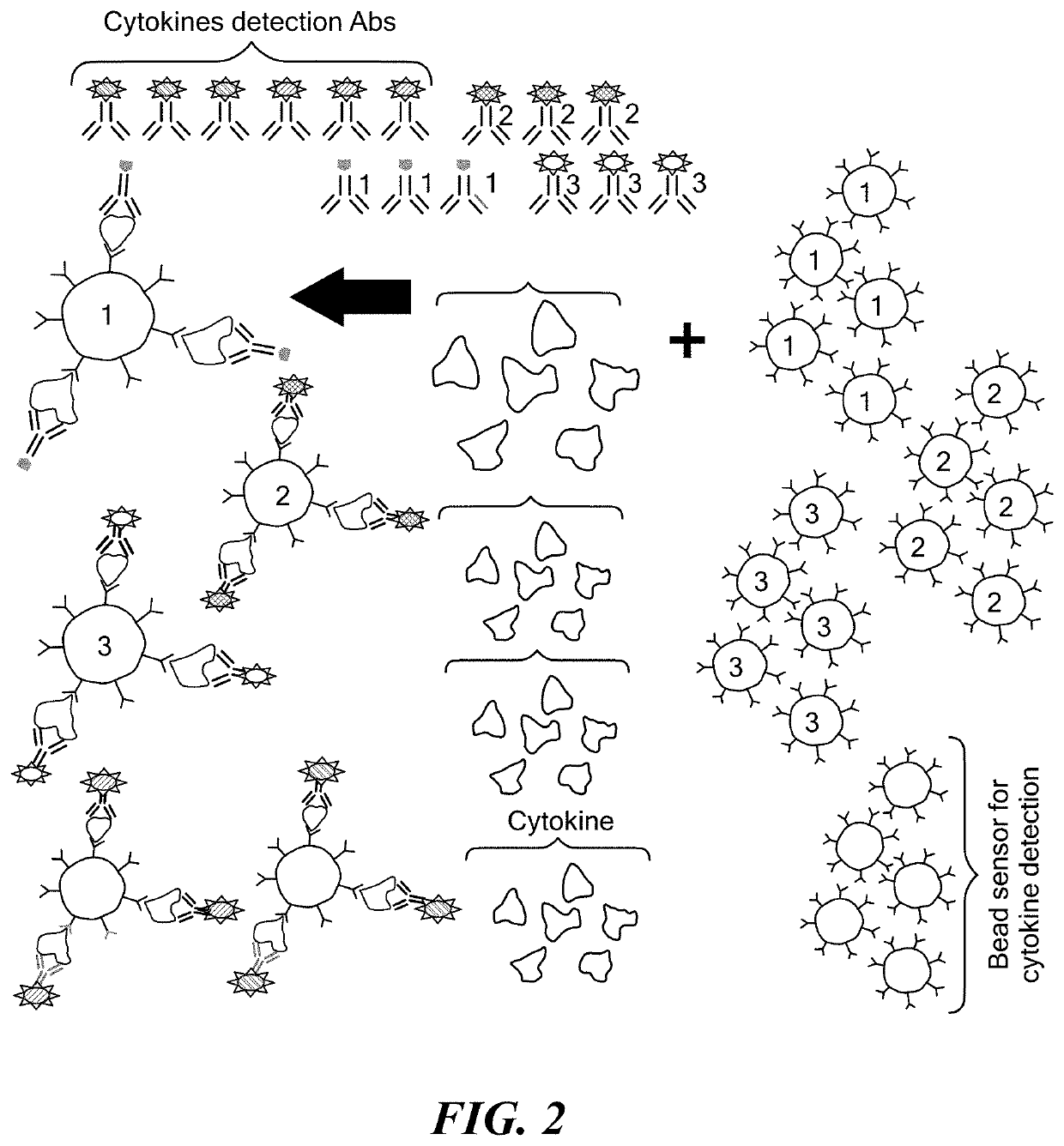Microdroplet Based Bioassay Platform
a bioassay and microdroplet technology, applied in the field of microdroplet based bioassay platforms, can solve the problems of significant morbidity, significant gap in the effective management of microbial infections, and presents a significant challenge to uti management, and achieve high throughput testing of the susceptibility of single cells and efficient monitoring of bacterial infection and cell function
- Summary
- Abstract
- Description
- Claims
- Application Information
AI Technical Summary
Benefits of technology
Problems solved by technology
Method used
Image
Examples
example 1
re-Based Assay for Simultaneous Analytical Detection of Common Uropathogens
[0050]Common causative agents for UTI, including Escherichia coli, Klebsiella pneumoniae, Enterobacter, Pseudomonas aeruginosa, and Proteus, can be detected in a multiplex assay. Multiplex bead array assays can be found as far back as 1977. (50-54) A wide assortment of tests have been devised for bead-based assays using both immunological and molecular ligands. However, a robust bead-based assay to capture and analyze bacteria has not yet been developed. Here, a bead-based protocol is disclosed with ultrahigh detection sensitivity and specificity of antigen-antibody reactions to identify bacterial presence in urine samples. The multiplex capabilities of the assay were used to detect several bacterial pathogens in urine samples simultaneously. The developed bead based detection protocol was validated for specificity and sensitivity as well as calibrated for determining the bacterial inoculum in the sample.
Prep...
example 2
nt of System for Differential Diagnosis and Antimicrobial Susceptibility Testing
[0059]In this example, disclosed is a fully integrated droplet based microfluidic device to detect and establish antimicrobial susceptibility within intact droplets is disclosed. The technology developed herein includes: 1) bead sensors and detection assay reagents as well as urine sample co-encapsulation to generate droplet based microreactors for detection, 2) droplet microarray technology to analyze the captured bacteria and 3) droplet merging technology for timely delivery of antimicrobials for susceptibility testing.
Microbead-Based Assay Using IL-6 and IL-8 Cytokine Interrogation
[0060]Two chips disclosed below are designed with variations on geometry to meet the single bacteria interrogation and co-encapsulation with assay reagents and antimicrobial agent requirements. The first design presents a simpler approach, where the polydimethylsiloxane (PDMS) chip is generated using standard soft lithograph...
example 3
c Validation
[0072]The use of a microfluidic system for bacterial detection and quantification of select pathogens in patient clinical samples and associated IL-6 / IL-8 cytokine levels is exemplified.
[0073]Clinical urine culture samples are collected in urine transport tubes that stabilize uropathogen numbers and viability, and urine samples are stored at 4° C. immediately after specimens are cultured and are therefore available for later analysis. Retrieved urine samples may be tested and correlated with clinical reports and parallel determination of CFU / mL of specific organisms. Clinically, urine cultures are plated using calibrated loops and results reported out quantitatively in log 10 concentration. More specifically, for clinical reporting, urine culture results are divided into four quantitative categories: no growth, 100,000 CFU / ml. Isolates are also speciated by the Vitek 2 (Biomerieux) automated identification system. Biotype numbers (a numerical summary of biochemical react...
PUM
| Property | Measurement | Unit |
|---|---|---|
| volume | aaaaa | aaaaa |
| volume | aaaaa | aaaaa |
| volume | aaaaa | aaaaa |
Abstract
Description
Claims
Application Information
 Login to View More
Login to View More - R&D
- Intellectual Property
- Life Sciences
- Materials
- Tech Scout
- Unparalleled Data Quality
- Higher Quality Content
- 60% Fewer Hallucinations
Browse by: Latest US Patents, China's latest patents, Technical Efficacy Thesaurus, Application Domain, Technology Topic, Popular Technical Reports.
© 2025 PatSnap. All rights reserved.Legal|Privacy policy|Modern Slavery Act Transparency Statement|Sitemap|About US| Contact US: help@patsnap.com



